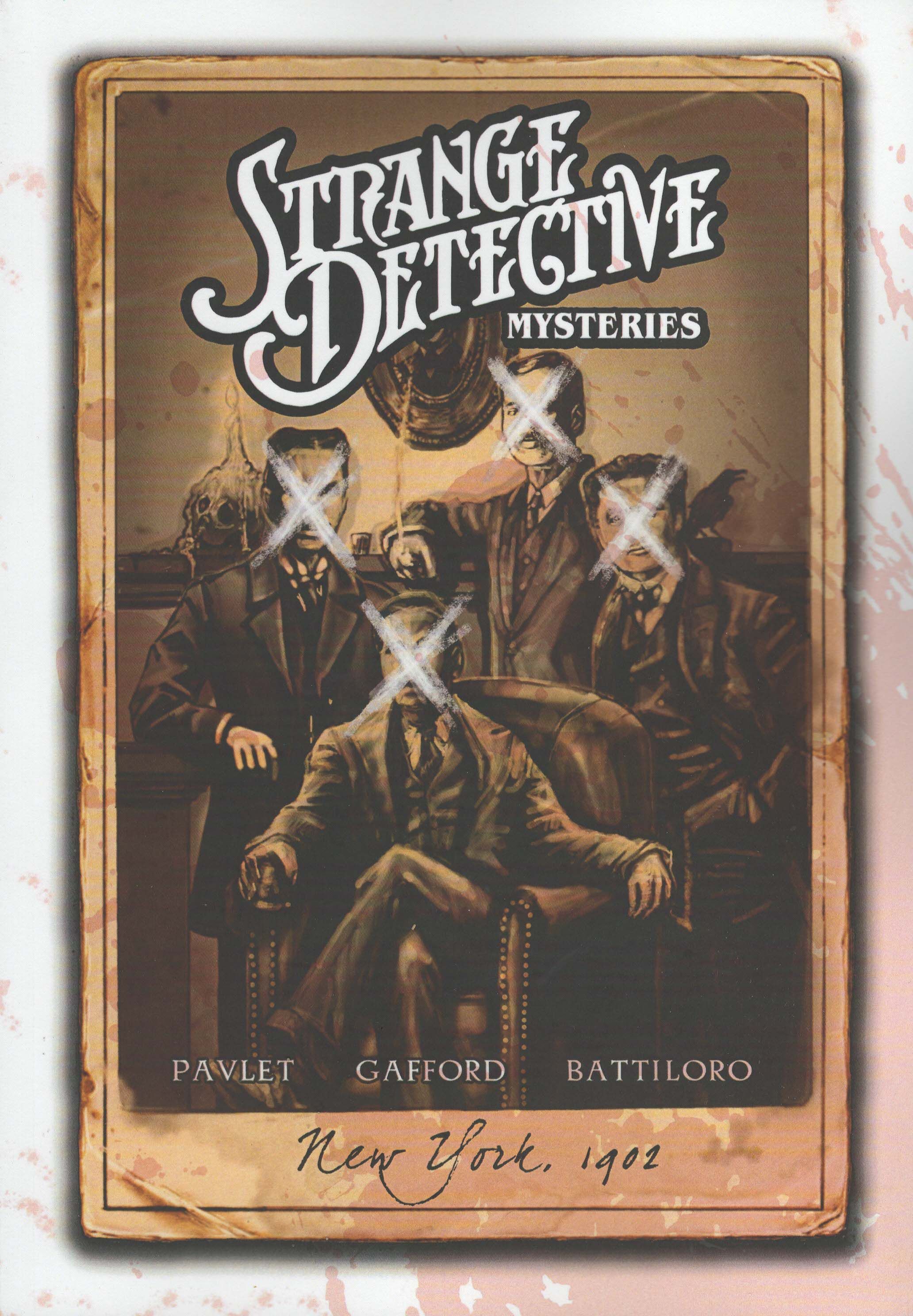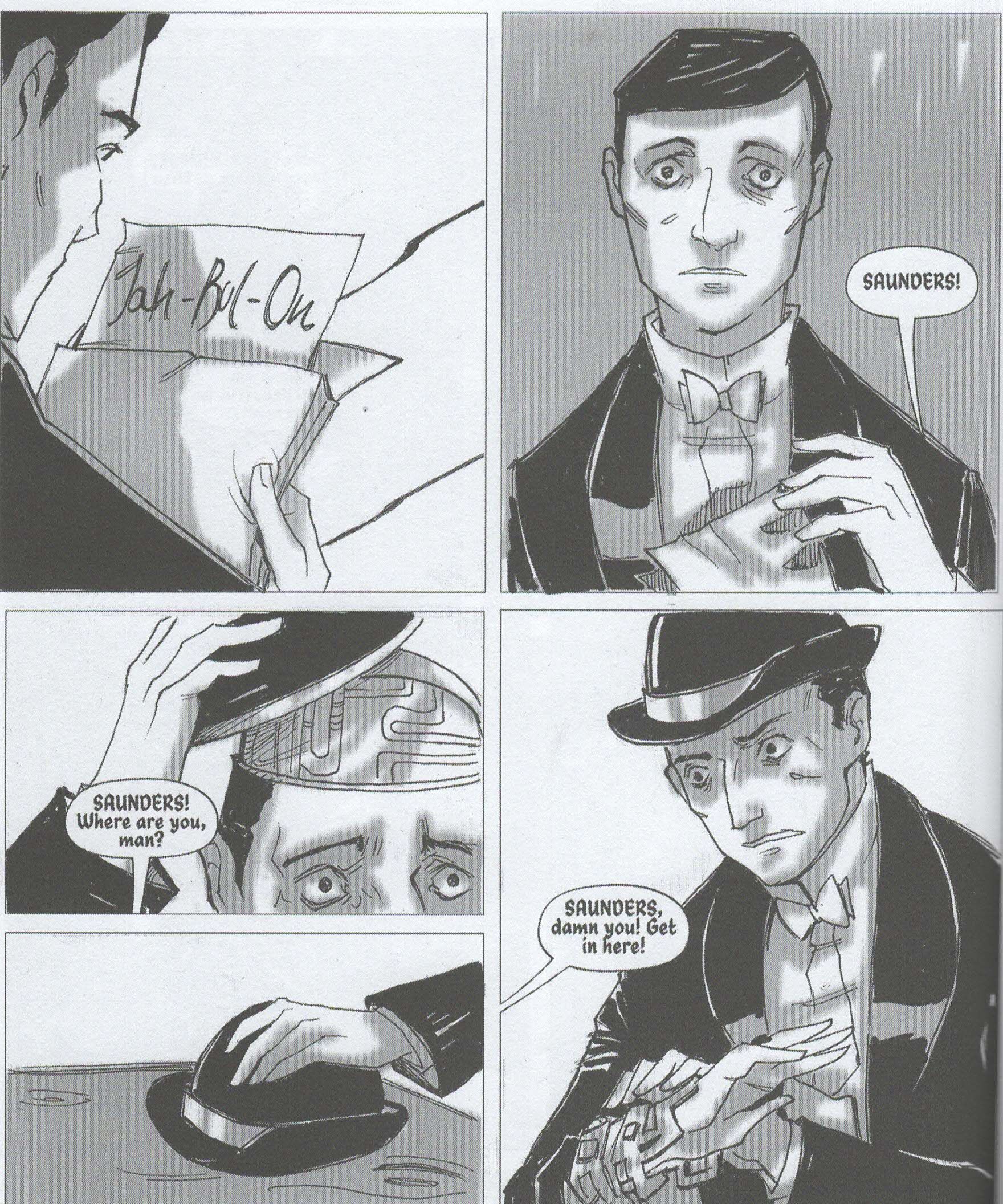"Gangster lean, feelin' so mean, I try to take more than their share / 'Cause all they saw was ruling it all, the scent of blood was in the air"
Strange Detective Mysteries was apparently published digitally first, but the collected edition came out in January, and as I am a print-version sucker, I picked it up. Don't question my life choices!
It's from Caliber Comics, and it's written by Sam Gafford (who is credited as co-creator with Terry Pavlet, who also gray-toned the book), drawn by Rosaria Battiloro, and lettered by E.T. Dollman. It will cost you a mere $13.99!
Strange Detective Mysteries starts off with a fine but somewhat tired premise. In 1902 New York, an old man named Richard Taylor (he introduces himself as Robert Tyler; unfortunately, his name changes during the course of the book, but based on the biographical information in the back of the book, we'll stick with "Taylor") invites five interesting gentlemen to a private club, where he introduces them all to each other. The men are H.G. Wells, Harry Houdini, Nikola Tesla (sigh), Arthur Conan Doyle, and Bat Masterson. He offers to pay them or otherwise give them what they crave if they will help him solve a murder ... the murder of Edgar Allan Poe, to be precise. The fact that Poe died in 1849 doesn't faze Taylor one bit, nor does the fact that nobody seems to think he was, you know, killed. Taylor claims to be the target of a conspiracy that involves Poe's murder, but before he tells them anything else, Wells and Houdini decide not to help.
Later they're both attacked by men who seem to think they're helping Taylor, which, of course, drives them back to the group. And so the investigation begins!
When I began reading this, I didn't have good feelings about it. I figured it would be entertaining, because I'm easily entertained, but I also thought it would be something of a trifle. I've read stories starring actual historical figures coming together to fight crime - Alan Moore might have done something like this - and while they're usually fun if the author has any competence, they've become almost a dime a dozen. Tesla and Conan Doyle actually figure out that this might have something to do with Jack the Ripper, which made me severely roll my eyes. The Ripper could easily have been still alive in 1902 and still committing crimes, of course, but it's just so ... pedestrian. Again, I figured this would be mildly entertaining, but that's about it.
Then the cyborgs showed up.
Yes, the men who try to kill Wells and Houdini are cyborgs. While this doesn't quite mean the book becomes awesome, it does kick it into a slightly more batshit insane zone, which is really never a bad thing.
Gafford and Pavlet throw us into a world full of Freemasons (which, sigh again), ancient gods, and time travel. I don't want to give too much away, but the book gets increasingly ridiculous, which actually makes it far more entertaining than if it had simply stayed a murder mystery starring famous historical figures. The five famous figures are joined by a time-traveling woman who tries to explain to them what's going on, and part of the odd humor of the book comes from the fact that they, naturally, do not believe and, indeed, think she might be insane. Things continue to go awry in the strangest ways, until we get the final confrontation, which again, turns things upside-down a bit. I have mentioned before (maybe not on this blog, but in real life and elsewhere on-line) of my admiration of The Rapture, the Mimi Rogers movie from 1991 (which also stars a pre-X-Files David Duchovny). Part of the reason I like it is because Michael Tolkin, who wrote and directed it, isn't afraid to take the movie to its logical conclusion, something not all works of fiction do. There's always a deus ex machina that ensures things get reset or the main characters don't suffer, which can be entertaining but is often completely contrary to the spirit of the work. I admire fictional works that are willing to say, "This is what would probably happen, so this is where we will go with it." Gafford and Pavlet do that, to a degree. The end of the book stumbles because the bad guys' scheme is rather weak, but the way we reach the end is plausible and shows us that the writers are fearless.
The ending is a big joke, and while it's not really explained, unfortunately, it's completely in line with their mission to see the plot through even as it becomes more and more ridiculous. I appreciate the balls that Gafford and Pavlet had to take this comic where they did, even if the execution isn't completely great. There's something to be said for fearlessness in fiction.
Battiloro does solid work on the artwork, as she gives us decent look at turn-of-the-century New York. She has a blocky, angular style that fits the more stereotypically harsh world of 1902 New York; everyone wears "sharp" clothes like jackets and ties, the architecture is brutally utilitarian, and even the weapons tend to be bladed. She doesn't do as well with the action, but there's not a lot of it, so that's okay. Her characters do some nice acting, and she moves them around the pages well, even trying some interesting things like a "split screen" effect when Houdini and Wells are attacked by the cyborgs. Pavlet's grayscales are used very well, and in the flashbacks, the art looks more painted, which is pretty clever. The biggest problem with the art is that so many characters have mustaches. That's not a big deal with the minor characters, but only Houdini of the main characters is clean-shaven, and Battiloro often doesn't do enough to distinguish them. When she introduces them, she gives them slightly different mustaches, but they seem to vary throughout the book.
Gafford doesn't always have other characters refer to them by name, so it's often hard to figure out who's speaking. It's a bizarre problem to have, I know, but it's still frustrating. For the most part, however, Battiloro does a good job, even if it's clear the success of the book doesn't depend on the art as much as some. Her style does tend to ground the comic, though, which is a good thing as it turns into ... what it turns into.
I don't love Strange Detective Mysteries, but it's certainly an interesting attempt to take some standard genre tropes and completely upend them. I think that Pavlet and Gafford didn't think enough about the plot, as it does seem slight compared to the spectacle surrounding it, and it really shouldn't. I mean, the murder of Edgar Allan Poe is kind of swept under the carpet a little - they try to resolve it, but it feels more like they did so because they, you know, brought it up rather than having any good idea for it occurring. But the wackiness of the story goes a long way and makes the comic far more interesting than it has any right to be. Gafford and Pavlet put the throttle down and care not where they end up - even if the joke at the end comes a bit out of nowhere, it's still ballsy to end with it - and that does help cover up some of the inconsistencies in the plot. This is a crazy comic, and in a world where a lot of comics claim to be crazy, the fact that this one actually is makes it a fascinating read. It's certainly not like very much out there, which is not a bad thing at all!
Rating: ★ ★ ★ ★ ★ ★ ½ ☆ ☆ ☆







